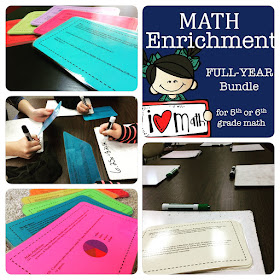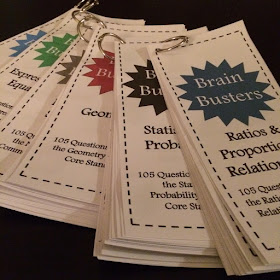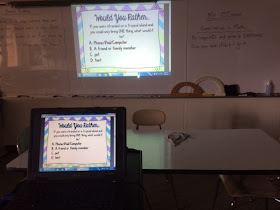First up are these Math Enrichment Task Cards. I created these task cards to challenge my students who quickly understood whatever concept we were learning about. The bundle includes 1-3 challenging problems for 87 different lessons, ranging from geometry to algebra (and everything in between!). All in all, the bundle includes 162 of these enrichment questions. Students love the challenge and it has really helped my higher students continue to grow (and not get bored!). I created them for sixth grade math, but have gotten a lot of feedback from fifth grade teachers who have found them useful as well! I personally use them at my front table during math workshop (at our Teacher Center), but they could easily be used in a lot of other ways!
Another fun bundle that is included in this Mega Math Bundle are my Math Brain Busters. This bundle includes six different Brain Buster sets. I created one set of Brain Busters that relate to five of the Common Core standards for sixth grade math and one additional variety set. With these problems, I enjoy how students are able to self check their work. They read and solve the problems on the front of each card and can then check their answers on the back. I have also found that students enjoy the format of these Brain Buster sets. I have used these in several different ways in my classroom...as a math center, for students who finish work early, and with my math intervention groups. If you combine all six sets, this bundle includes 675 problems for students to solve!
One of my newest bundles is this Connect Four Bundle. I just recently used my Connect Four: Multiplying Decimals game and the students really enjoy playing. For 14 different topics that my students study throughout the year, I created a Connect Four game. In the game, students solve problems and then cover up that answer on their board. The first person to connect four in a row wins! Each of the 14 games include six game boards and sixteen problem cards. This is a great one to use as a math center or use with intervention groups!
 Another math game that comes in handy as a math center once we move into our algebra units are these Equation Top-it games. Every time we did any math activity with a deck of cards, I always had students asking if they could play the card game War. This gave me the idea to make a math game that incorporates the rules of War, only math related. In this game, students divide up the equation cards evenly. After each flipping over a card, they must solve the equation on the card. Whoever has the greatest solution gets both of the cards and adds them to their deck. This bundle includes sets for addition, subtraction, multiplication, division, and two-step equations! Also, each of the five sets includes a beginner and difficult set to help differentiate. I usually have my students start with the beginner set and then have the difficult set ready to go if it seems too easy! This is a game that makes solving equations fun! I have used this as a math center, in partners (as a whole class), and in my math intervention group.
Another math game that comes in handy as a math center once we move into our algebra units are these Equation Top-it games. Every time we did any math activity with a deck of cards, I always had students asking if they could play the card game War. This gave me the idea to make a math game that incorporates the rules of War, only math related. In this game, students divide up the equation cards evenly. After each flipping over a card, they must solve the equation on the card. Whoever has the greatest solution gets both of the cards and adds them to their deck. This bundle includes sets for addition, subtraction, multiplication, division, and two-step equations! Also, each of the five sets includes a beginner and difficult set to help differentiate. I usually have my students start with the beginner set and then have the difficult set ready to go if it seems too easy! This is a game that makes solving equations fun! I have used this as a math center, in partners (as a whole class), and in my math intervention group.Next up...BINGO! The three bingo games that are included in my Math Bingo Bundle were a some of the first math games I made when I began teaching. I still use these quite often as a way to practice basic facts, multiplying negative numbers, and squares/square roots! The bundle includes three bingo games...Multiplication Bingo, Negative Number Bingo, and Squares and Roots Bingo. Each set includes 30 unique game boards and calling cards. The Multiplication Bingo is a great one for students who are still in the process of mastering their basic multiplication facts. I usually start the year playing Multiplication Bingo, then begin incorporating Negative Number Bingo and Squares and Roots Bingo as my students begin to really master their basic facts.
For the first time last school year, I tried doing a math scavenger hunt with my students. I'm not going to lie, I was pretty nervous about how they would handle it and how it would go. Turns out, it was extremely engaging! For whatever reason, the idea of a scavenger hunt was all it took to help motivate ALL of my students. I had several students asking why we couldn't do one every day! What is really great about these is it gets the students up and moving around the room. My Math Scavenger Hunt Bundle includes 7 different scavenger hunts. Each includes twelve problems that are posted around the room. Once a student solves a problem, they must walk around and find that answer on the top of their next problem.
These are just some of the math resources that are included in my Math Mega Bundle. There are several more that I didn't highlight in this post (Math Jeopardy games, a Stock Market Challenge, flash cards, a fun probability activity, and more!). I also included all of my free products from my store! I encourage you to head over to my Math Mega Bundle and take a look at everything that is included in its description.















